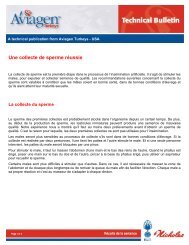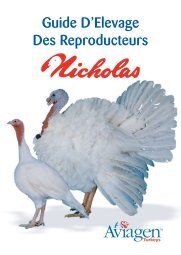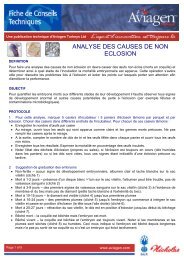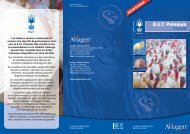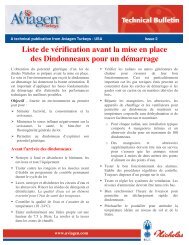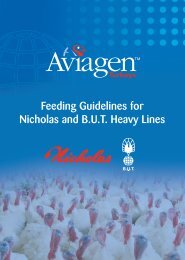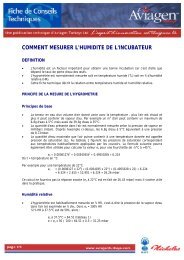minimum ventilation during cold weather - Aviagen Turkeys
minimum ventilation during cold weather - Aviagen Turkeys
minimum ventilation during cold weather - Aviagen Turkeys
Create successful ePaper yourself
Turn your PDF publications into a flip-book with our unique Google optimized e-Paper software.
Minimum Ventilation During Cold Weather<br />
Michael Czarick – Extension Engineer • Poultry – University of Georgia<br />
Knowing how much to ventilate <strong>during</strong><br />
<strong>cold</strong> <strong>weather</strong> is crucial to a producer’s<br />
bottom line. Ventilating too little can lead<br />
to poor air and litter quality, resulting<br />
in bird health and performance issues.<br />
Ventilating too much can lead to drafty<br />
conditions and high heating costs. The<br />
first step to knowing how much you need<br />
to ventilate <strong>during</strong> <strong>cold</strong> <strong>weather</strong> is to<br />
understand which air quality variables<br />
are most likely to cause problems.<br />
The three primary air quality variables<br />
turkey producers need to manage,<br />
besides temperature, in a turkey house<br />
<strong>during</strong> <strong>cold</strong> <strong>weather</strong> are carbon dioxide,<br />
humidity, and ammonia.<br />
Target levels to maximize bird<br />
performance:<br />
• Carbon dioxide concentrations<br />
below 5,000 ppm<br />
• Relative humidity around 50%<br />
• Ammonia concentrations<br />
below 30 ppm<br />
Managing Carbon DioxiDe<br />
Carbon dioxide is produced by the birds<br />
as well as by a house’s heating system.<br />
High carbon dioxide concentrations can<br />
lead to lethargic poults and reduced<br />
performance. Figure 1 illustrates the<br />
approximate <strong>minimum</strong> <strong>ventilation</strong> rate<br />
(cfm per 1,000 birds) required to maintain<br />
a carbon dioxide concentration below<br />
5,000 ppm. The graph assumes the only<br />
source of carbon dioxide is the birds,<br />
which typically is not the case with<br />
younger birds. When propane/natural<br />
gas is burned it adds a significant<br />
amount of carbon dioxide to the<br />
environment.<br />
Minimum Ventilation Rate (Cfm per 1,000)<br />
2,400<br />
2,300<br />
2,200<br />
2,100<br />
2,000<br />
1,900<br />
1,800<br />
1,700<br />
1,600<br />
1,500<br />
1,400<br />
1,300<br />
1,200<br />
1,100<br />
1,000<br />
900<br />
800<br />
700<br />
600<br />
500<br />
400<br />
300<br />
200<br />
100<br />
0<br />
0 1 2 3 4 5 6 7 8 9 10 11 12 13 14 15 16 17 18 19 20 21 22 23<br />
Bird Age (weeks)<br />
Figure 1. Minimum <strong>ventilation</strong> rates required to limit carbon dioxide<br />
During <strong>cold</strong> <strong>weather</strong> the heating system<br />
can add two to four times more carbon<br />
dioxide to the house than the birds.<br />
To be on the safe side, <strong>during</strong> <strong>cold</strong><br />
<strong>weather</strong> in brooder houses it is typically<br />
best to double and possibly triple the<br />
rates depicted in Figure 1.<br />
Managing relative HuMiDity<br />
Insufficient <strong>ventilation</strong> <strong>during</strong> <strong>cold</strong><br />
<strong>weather</strong> can also lead to a buildup of<br />
moisture in a house, resulting in damp<br />
litter and all the associated problems.<br />
If, however, a producer ventilates too<br />
much not only will it result in high<br />
heating costs, but the resulting low<br />
relative humidity can lead to dusty<br />
house conditions.<br />
Page 1 of 4 TB Issue 7 – Cold Weather Ventilation<br />
The chart in Figure 2 provides a way to<br />
determine <strong>minimum</strong> <strong>ventilation</strong> rates to<br />
control house humidity from daily water<br />
consumption and house temperature.<br />
For every pound of feed, a bird will drink<br />
approximately a quart of water. The older<br />
the birds get, the more feed they eat, the<br />
more water going into the house that we<br />
have to get rid of through <strong>ventilation</strong>.<br />
If we know how much water is going<br />
into a house, the inside and outside<br />
temperatures, and have a target for<br />
inside relative humidity, then we can<br />
calculate how much we need to ventilate<br />
to rid the house of the moisture the birds<br />
are adding.
Minimum Ventilation Rate (Cfm)<br />
22,000<br />
21,000<br />
20,000<br />
19,000<br />
18,000<br />
17,000<br />
16,000<br />
15,000<br />
14,000<br />
13,000<br />
12,000<br />
11,000<br />
10,000<br />
9,000<br />
8,000<br />
7,000<br />
6,000<br />
5,000<br />
4,000<br />
3,000<br />
2,000<br />
1,000<br />
0<br />
65 o F<br />
70 o F<br />
75 o F<br />
80 o F<br />
85 o F<br />
90 o F<br />
100<br />
150<br />
200<br />
250<br />
300<br />
350<br />
400<br />
450<br />
500<br />
550<br />
600<br />
650<br />
700<br />
750<br />
800<br />
850<br />
900<br />
950<br />
1,000<br />
1,050<br />
1,100<br />
1,150<br />
1,200<br />
1,250<br />
1,300<br />
1,350<br />
1,400<br />
1,450<br />
1,500<br />
1,550<br />
1,600<br />
1,650<br />
1,700<br />
1,750<br />
1,800<br />
1,850<br />
1,900<br />
1,950<br />
2,000<br />
Water Consumption (gallons per day)<br />
Figure 2. Minimum <strong>ventilation</strong> rates required to manage house moisture based on bird water usage and inside temperature<br />
the fact is that when it is <strong>cold</strong>, outside<br />
relative humidity really doesn’t have<br />
a large effect on how much we need<br />
to ventilate to control moisture in the<br />
house because <strong>cold</strong> air, whether at<br />
40% or 100% relative humidity, actually<br />
contains very little moisture.<br />
For instance, if <strong>during</strong> brooding it is<br />
90 o F (32 o C)and 60% Rh, there would be<br />
approximately 20 ounces of water in<br />
every 1,000 cubic feet of air in the<br />
house. If outside it were 40 o F (4 o C) and<br />
50% Rh, there would be 3 ounces of<br />
water in every 1,000 cubic feet of air.<br />
When the <strong>minimum</strong> <strong>ventilation</strong> fans<br />
come on, for every 1,000 cubic feet of<br />
air we bring in, we are bringing in 3<br />
ounces of water.<br />
The good news is that although we are<br />
bringing in 3 ounces of water, we are<br />
at the same time exhausting 20 ounces<br />
of water. Even though when we are<br />
What about outside relative humidity?<br />
ventilating, we are bringing in some<br />
moisture, the fact is we are exhausting<br />
air with significantly more moisture,<br />
which results in an overall reduction in<br />
house moisture levels.<br />
Now, let’s say that it is 40 o F (4 o C) and<br />
80% Rh outside. Under these conditions<br />
there would be 5 ounces of water in<br />
every 1,000 cubic feet of air we brought<br />
into a house. But again, since the inside<br />
air has 20 ounces of moisture for every<br />
1,000 cubic feet we would be removing<br />
15 ounces (20 ounces - 5 ounces) of<br />
moisture for every 1,000 cubic feet of<br />
air we moved into and out of the house.<br />
As you can see, even though the<br />
humidity is much higher outside than<br />
in the first example it only reduced<br />
the amount of moisture we removed<br />
from the house by a little over 10%.<br />
So, even though technically a <strong>minimum</strong><br />
<strong>ventilation</strong> chart should take into<br />
account outside relative humidity, for<br />
the most part you can obtain fairly<br />
accurate results with a chart that<br />
assumes an outside relative humidity<br />
of 50%.<br />
outside temperature has more of an<br />
effect on <strong>minimum</strong> <strong>ventilation</strong> settings<br />
than does outside relative humidity.<br />
The <strong>minimum</strong> <strong>ventilation</strong> rates<br />
provided in Figure 2 are based on an<br />
outside temperature of 30 o F. (-1 o C). The<br />
<strong>minimum</strong> <strong>ventilation</strong> rates indicated can<br />
be adjusted for very <strong>cold</strong> or moderate<br />
conditions. For instance, if the <strong>minimum</strong><br />
outside temperature is 50 o F, 20 o F<br />
warmer, (10 o C, 11 o C warmer) <strong>minimum</strong><br />
<strong>ventilation</strong> settings should be increased<br />
by approximately 25%. If the <strong>minimum</strong><br />
outside temperature is 9 o F, 10 o F <strong>cold</strong>er,<br />
(-11 o C, -10 o C <strong>cold</strong>er) the <strong>minimum</strong><br />
<strong>ventilation</strong> rates can be decreased 25%.<br />
Page 2 of 4 TB Issue 7 – Cold Weather Ventilation
Controlling aMMonia<br />
Last but not least, we need to ventilate<br />
enough <strong>during</strong> <strong>cold</strong> <strong>weather</strong> to<br />
control ammonia. High ammonia<br />
concentrations can lead to reduced bird<br />
weights, increased feed conversions,<br />
and increased incidence of respiratory<br />
problems. The problem is that there isn’t<br />
a <strong>minimum</strong> <strong>ventilation</strong> chart to provide<br />
a <strong>minimum</strong> <strong>ventilation</strong> rate to control<br />
ammonia. This is because though the<br />
moisture and carbon dioxide produced<br />
by the birds doesn’t change much from<br />
farm to farm, ammonia production is<br />
very hard to accurately predict.<br />
The amount of ammonia produced is a<br />
function of factors such as age of litter,<br />
litter moisture, amount of caked litter,<br />
and length of downtime between flocks.<br />
At this time the best way to determine<br />
how much you need to ventilate to<br />
control ammonia is to simply set a<br />
couple of 36” fans to run a minute or<br />
so out of five and measure the ammonia<br />
concentration right after the fans<br />
shut off.<br />
if you want to cut the ammonia<br />
concentration in half, double your<br />
timer setting.<br />
If it is very low, and you think it would be<br />
okay to double the concentration, then<br />
cut your timer fan settings in half.<br />
DeterMining Fan SettingS<br />
Which variable – carbon dioxide, relative<br />
humidity or ammonia – should be used<br />
to determine timer fan settings?<br />
ideally, you should determine <strong>minimum</strong><br />
<strong>ventilation</strong> rates based on the variable<br />
that requires the highest <strong>minimum</strong><br />
<strong>ventilation</strong> rate.<br />
For instance, if you have a house with<br />
built-up litter and you are not using a<br />
litter treatment, you will probably find<br />
that the <strong>minimum</strong> <strong>ventilation</strong> rate to<br />
control ammonia concentration will<br />
be the highest. With a freshly cleaned<br />
out house, you may find that relative<br />
humidity will be the controlling air<br />
quality variable. In a house with very dry<br />
fresh litter, managing carbon dioxide<br />
might be the determining factor.<br />
In an ideal situation we wouldn’t use any<br />
charts. Producers would have meters to<br />
measure ammonia, relative humidity,<br />
and carbon dioxide and then make<br />
adjustments to <strong>minimum</strong> <strong>ventilation</strong> fan<br />
settings accordingly. In most cases this is<br />
not possible.<br />
To date, there hasn’t been an ammonia<br />
meter that has been proven to accurately<br />
measure ammonia in a poultry house<br />
on a continuous basis. Yes, there are<br />
some meters that can be taken into a<br />
house for a short period to measure<br />
ammonia, but they tend to be expensive<br />
($1,000+), require frequent calibration,<br />
and the meter’s sensor typically has to<br />
be replaced once a year at significant<br />
expense (over $400), putting them out of<br />
the reach of most producer.<br />
Carbon dioxide meters cost around<br />
$500, though typically less problematic<br />
than ammonia meters, they are not<br />
particularly useful because for the most<br />
part carbon dioxide is not very likely to<br />
be a significant problem on most farms<br />
except for the first couple of weeks in the<br />
brooder house.<br />
This brings us to relative humidity<br />
meters/sensors. For the most part,<br />
they are very reliable and relatively<br />
inexpensive. Furthermore, relative<br />
humidity is what we typically are<br />
most interested in controlling <strong>during</strong><br />
<strong>cold</strong> <strong>weather</strong>.<br />
The fact is that if we properly manage<br />
humidity in our houses we will keep<br />
ammonia and dust from becoming<br />
problems in the first place. If a house<br />
has fresh shavings and it is ventilated<br />
to control relative humidity from day<br />
one, then litter caking will be kept to a<br />
<strong>minimum</strong>, and therefore, keep ammonia<br />
from being a major problem.<br />
a relative humidity meter/sensor is a<br />
<strong>ventilation</strong> tool that no poultry house<br />
should be without.<br />
Trying to determine how much to<br />
ventilate a house is always going to be<br />
a challenge. Balancing the well-being<br />
of the birds and heating costs is difficult<br />
at best. But, the better you understand<br />
the goals of <strong>minimum</strong> <strong>ventilation</strong> rates<br />
<strong>during</strong> <strong>cold</strong> <strong>weather</strong>, the more likely<br />
you will have optimal bird health and<br />
performance and the less likely you will<br />
be to over ventilate your houses, which of<br />
course will lead to higher heating costs.<br />
About the authOr<br />
Michael Czarick III is an extension<br />
biological and agricultural engineer<br />
at The University of Georgia. He is<br />
considered by the poultry industry<br />
and the academic community as<br />
a leading authority on the design<br />
and operation of poultry house<br />
environmental control systems.<br />
Mr. Czarick has given presentations<br />
on poultry house environmental<br />
control and energy conservation<br />
in 35 countries and has authored<br />
numerous publications, including<br />
scholarly journals and industryrelated<br />
pieces. His unique ability to<br />
explain relatively complex <strong>ventilation</strong><br />
concepts in an easy-to-understand<br />
way has made him a highly soughtafter<br />
speaker around the world.<br />
Page 3 of 4 TB Issue 7 – Cold Weather Ventilation
The contents of this Technical Bulletin are © <strong>Aviagen</strong> <strong>Turkeys</strong>, Inc. and the advice contained herein is given as a<br />
guide and may need to be varied to meet a specific customer operation; in any event, this advice should not be<br />
regarded as a form of guarantee.<br />
aviagen turkeys inc.<br />
31186 Midland Trail, East • Lewisburg, West Virginia 24901 • USA<br />
Tel: +1 304 793 2680 Fax: +1 304 793 2684<br />
turkeysinc@aviagen.com<br />
aviagen turkeys ltd.<br />
Chowley Five, Chowley Oak Business Park • Tattenhall, Cheshire CH3 9GA<br />
Tel: +44 (0)1829 772020 Fax: +44 (0)1829 772059<br />
turkeysltd@aviagen.com<br />
Web: www.aviagen.com<br />
visit aviagen.com for a complete library<br />
of Technical publications<br />
Page 4 of 4 TB Issue 7 – Cold Weather Ventilation




